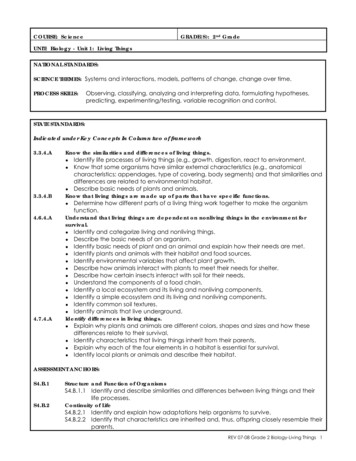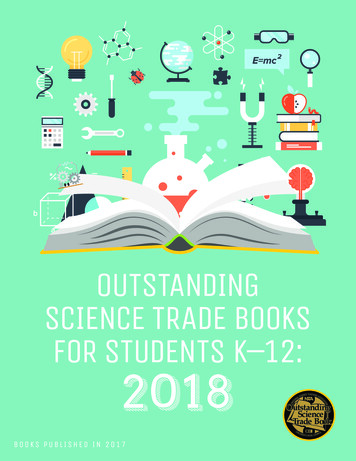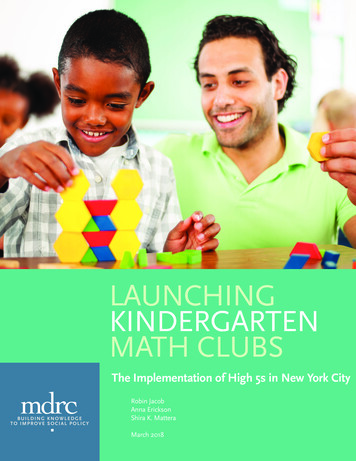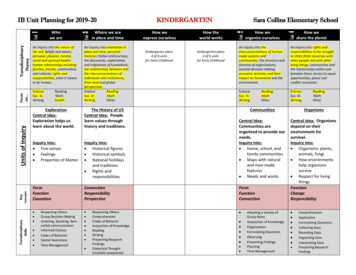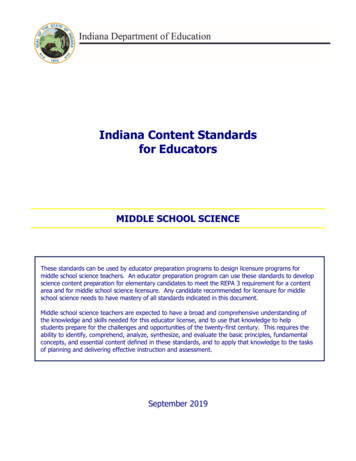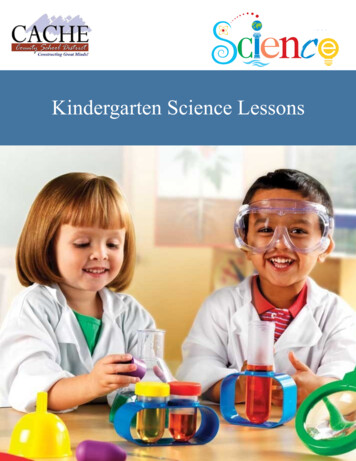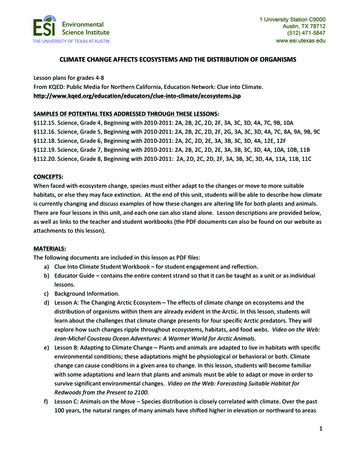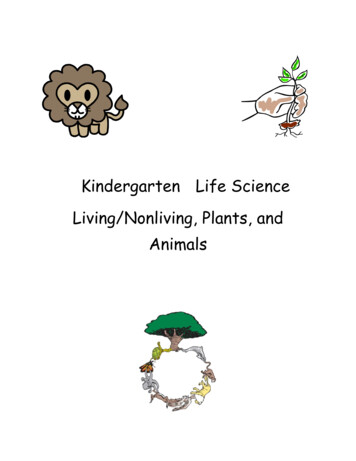
Transcription
Kindergarten Life ScienceLiving/Nonliving, Plants, andAnimals
UBD Stage 1Establish Goals:Kindergarden MN Science Standard4 Life Science0.4.1.1.1 observe and compare plants and animals0.4.1.1.2 Identify the external parts of a variety of plants and animalsincluding humans.0.4.1.1.3 Differentiate between living and nonliving things.0.4.2.1.1 Observe a natural system or its model, and identify living andnonlivingcomponents in that system.What understandings are desired?Students will understand that . . . . . . . . . . Goal topic: plants and animals1. Difference between living and nonliving2. Parts of a plant3. Parts of an animal4. Classification and comparing of plants and animals.What essential questions will be considered? How are animals and plants interconnected? What would happen if there were no plants? Why are there different types of animals and plants?What key knowledge and skills will students acquire as a result of this unit?Studnets will know. . . . . . Life cycles of plants Living and nonliving things Plant parts Plant types Animal parts Animal types What is the natural system orenvironmentStudents will be able to . . . . . . . . Name the parts of plants Construct a plant or animal diagramfrom parts that they are given. Identify living and nonliving things Classify animals and plants Classification of plants according totheir characteristics. Classification of animals accordingto their characteristics.
UBD Stage 2Collection of Assessment EvidencePerformance tasks: Planting Seeds: Students will plant a seed in a cup and record observations theysee in the growth of the seed. Students will be responsible for putting their plantin the window and watering it.Head to Toe: Students will work in pairs and draw a life size picture of them.Students will then label the part of the body and present it to the class.Other Evidence: (tests, quizzes, prompts, work samples, observations) Quiz on living and nonliving thingsPrompts on determining methods of categorizing animals.Work samples: worksheets, and journal pictures and labelingObservations on “planting seeds”Student Self-Assessment and Reflection Students will self- assess on “Planting Seeds”Students will self-assess on “Head to Toe”Students will reflect on characteristics on “What would happen if there were noplants in the world?”
Students will be introduced to the unit by group discussion and bulletin board made from our brainstormingsessions. At the beginning of a new segment of learning, we will make a new bulletin board to form T-charts and discussessential questions for each segment. A short letter to parents to explain the unit and types of projects their children will becompleting.Students will be engage in books that relate to each segment. Students will create projects to promote learning andunderstanding through different facets.Student will go on a nature walk and to Quarry Hill and after will discuss what we observed with our eyes, ears, hands,and nose. We will discuss essential question and as a group determine how those questions affect us.Students will reflect their ideas and concerns about questions in journal, group discussions, and graphic organizersdone as a whole group. Students will be given feedback throughout the unit though self-assessments on the Alien performancetask, and did my plant grow? project.Student will exhibit their understanding through the performance tasks and through weekly Test/Quizzes. I willcheck for understanding through a thumb up and thumb down during lessons and additional work samples.For students who are having difficulty with concepts of the lesson additional prompts when needed. Extensionsand more in-depth work will be available for those students who are at a higher level of learning.Unit Schedule
Day 1 Introduce the unit and briefly describe the assignments. Send home a letter to the parents describing the unit. Teacher will introduce Living and Nonliving things and as a group complete aT-chart on Living and Nonliving things.Day 2 Lesson plan on Living and Nonliving things this will help studentsdifferentiate between living and nonliving things. Students will learn what itmeans to be living and sort living and nonliving into categories.Day 3 We will review day 2’s lesson and as a group do a smart board lesson on livingand nonliving things. Living and Nonliving Classification things worksheet as a whole class Read book Living and Nonliving by Carol Lindeen . Students will journal on a What living plants do we eat?Day 4Day 5 Introduce the life cycle of plants and what they need to grow and survive.Read the book Learn new song “A seed needs” Students will plant their own plant and record what it looked like and if theywatered it.Day 6 Quiz on living and nonliving things. Show and Tell on favorite Living and Nonliving thing
Day 7 Introduction the different parts of the plant and their function. Read thebook The Tiny Seed by Eric Carle Students will put together the parts of the plant given pieces. T-chart Plant similarities and differences in plants Matching game worksheet of plants Basic plant parts Introduce plants and flowers found in Minnesota and sort them intro classifyDay 8Day 9them according to flowers and plants. Student reflection Worksheet Growing Seeds Record plant observations and discuss the results Make a chart on the growth of plants as whole class.Day 10Day 11 Test/Quiz on Plant parts and life cycle The Mixed Up Chameleon by Eric Carle Read book What Do You Do with a Tail Like This? By Steven Jenkins and RobinDay 12Page Students will journal on ideal animal with specific parts given to by the teacher. Present to the class your ideal animal. Read Animals Grow New Parts by Elanine Pascoe and Dwight Kuhn Journal on ideal animal and why?Day 13
Day 14 Read book Animal Grow New Parts by Elanine Pascoe, and Dwight Kuhn Review classification and characteristics of animals Matching game with partnersDay 15 Students will learn about characteristic of animals and classify according to them. Students will work in pair on Alien creature. Students will record the growth of their plants. Discuss and graph the results as a whole class.Day 16 Quiz on Animal parts.Day 17 Read book Living and Nonliving by Angela Royston. Review what makes something Living and Nonliving. Make a chart on things that are living and Nonliving Walk through the school and outside and with our eyes, ears, and nose observe allthe living and nonliving Discuss as a class all the things we observed with our eyes, ears, and nose.Day 18 Aquarium Identify the Living and nonliving parts Chart our findings as a classDay 19 Field trip to Quarry Hill
As a list of all the objects, we saw at Quarry Hill. Put them into a sort the objects into categoriesDay 20 Students will design an ecosystem from parts given to them and students will workin groups of four. Record the growth of plant and discuss as a class what has happened. Graph the results Assessment on plant growth
1Group T-ChartOf Living andNonliving things& video2Lesson Plan onLiving andNonliving &worksheet “ L&NLthings” worksheet3SmartboardLessonLiving and nonlivingClassification4Group discussionon Living thingsplants we eat andJournal5Lesson Plan onPlant Growthand plantingour seeds6Test/Quiz onLiving andNonliving Things& Show and Tell7Lesson Plan onPlant Parts8T-chart ondifferences onPlant Differencesand worksheetmatching game9Discussion on MNlocal flowers andhave pictureexamplesStudent Reflection10Record Plantgrowth andpredictionworksheetGrowing Seeds1112Test/Quiz on Plant Lesson Plan onparts and life cycle Animal parts withCompare andcontrast groupworksheet13Journal on yourideal animal andwhy?14Lesson Plan oncharacteristics ofanimals & colorand cut matchinggame with partner15Performance Task“Alien” & presentto classRecord growth onplant16Test/Quiz onAnimals18AquariumIdentify Living andNonlivingcomponents19Field Trip toQuarry Hillworksheet t-chartLiving andnonliving20Group Activitydesign andenvironment for youanimal (Day 13) inJournal17Lesson PlanReview Living andNonliving& Nature Walk
Resource List1. Living and Nonliving worksheet2. Classify Living and Nonliving worksheet3. Crayons4. Markers5. Glue6. Living and nonliving pictures7. Living/Nonliving Quiz/Test8. Living and Nonliving by Carol K Lindeen9. Living and Nonliving by Angela Royston10. Seeds11. 8-16oz cups12. Planting soil13. Watering cans14. Pictures of local MN flowers15. Worksheet for plant growth16. Test/quiz on Plant growth and life cycle17. Compare and contrast worksheet18. Journal notebooks19. Scissors20. Sheet on body parts21. Roll of paper for Alien performance task22. Video on Living and nonliving things (multimediaEducationTown.com) or youtube.com23. The Tiny Seed by Eric Carle24. A seed needs song25. Parts of a Plant26. Self –Assessment Plant27. A sunflower seed needs worksheet28. Plant pictures29. Plant parts30. Celery31. Food coloring32. Parts of a plant worksheet
33. What do you do with a tail like this? By Steven Jenkins and Robin Page34. Animal pictures35. Poster board36. Animal parts song37. Animal parts matching game38. Camera39. White boards with markers40. Permission slips for Quarry Hill41. The Mixed Up Chameleon by Eric Carle42. Animals Grow New Parts by Elanine Pascoe and Dwight Kuhn
Reference List1. www.HaveFunTeaching.com2. Science for Ohio web page3. urselves/living/living.htm4. Colorodo writing project5. http://worksheetplace.com6. www.abcteach.com7. www.kidsparkz.com8. www.toolsforeducators.com9. www.lessonplant.com10. www.atozteacherstuff.com11. www.amphi.com
Key for Quizzes/Test#1 Circle the nonliving thingsCupPizza#2 Plant Life Sequence1. Plant seed2. Water seed3. Plant growsLabel Parts1.2.3.4.StemFlowerLeafRoot# 3 Animal Parts circle1. Legs, nose face, tail, head, eyes, mouth, ears
Circle the nonliving things
RootsStemFlowerLeaves
Circle the parts this animal has.LegsTailEyesNoesHairMouthFaceHeadEarsWings
NameJournalDraw animal with the following partsbodytailearseyesnoselegs
NamePut the life cycle of the plant in order 123
NameDay123Draw picture ofDid you water yourplantplant
45678910
Lesson Title: Living and NonlivingDate: Day 2Teacher’s Name: Jennifer KlingGrade level: KMaterials needed for the lesson: “Living and Nonliving” “Classifying Living and Nonliving chart “What do I see outdoors & indoors living and nonliving chart” Crayons Glue Pictures of objects found in your classroom and outside on playgroundWhat is the lesson objective? The student will develop criteria for living and nonliving Classify things according to that criteriaStandards/benchmarks addressed:MN 4.1.1.3 Differentiate between living and nonliving things.Anticipatory Set: Make a graphic organizer and have student name living and nonliving thingsand write down on the board. Brainstorm on what makes something living or nonliving
Teaching/Instructional Process: read “Living and Nonliving” by Carol K. Lindeen Book questionso What do living things have in common?o What are characteristics of nonliving things?o What makes something living or nonliving? As a class have children name object to determine if it is Living and nonliving onworksheet givenGuided practice and monitoring: Nonliving and Living practice sort Walk around to monitor students and prompt when neededClosure: Review what makes something living and nonlivingIndependent Practice: Living and Nonliving Sort worksheet
Living
Nonliving
JournalWhat plants do we EAT?
Lesson Title:Planting My SeedDate: Day 6Teacher’s Name: Jennifer KlingGrade level: KMaterials needed for the lesson: From Seed to Dandelion Differ types of flowers and plants Water Soil Digital camera Computer Worksheet A sunflower seed growsWhat is the lesson objective? The learner will understand that plants have life cycles The learner will observe the changes in the life cycle The learner will able to place in the correct order the sequence the differentgrowth stages of a plant.Standards/benchmarks addressed:MN Life Science4.1.1.2Anticipatory Set: Learn song “A seed needs”Teaching/Instructional Process: Read the book From Seed to Dandeliono “How do you think these plants or flowers got here?”
o “How quick did they get here?”o “How long did it take them to grow this size?”o “What do they need to grow?”o “What would happen if plants don’t get what they need to grow?”Discuss the different stages of the cycle of a planto Seed, seed sprouts, roots, stem, leaves and flowersGuided practice and monitoring: Plant the seeds in a cup and soil Every other day students will water and record it on their sheet As a group review the different stages of the life cycle on the board. Will take pictures each week to record growthClosure: Review the life cycle in the book Essential for plant survivalIndependent Practice: Worksheet on plant cycle
Lesson Title: Plant partsDate: Day 7Teacher’s Name: Jennifer KlingGrade level: KMaterials needed for the lesson: Plant parts Glue Live plants Celery Food coloring “The Tiny Seed” by Eric Carle Markers Plant picturesWhat is the lesson objective?The student will be able to name and construct a plant given parts with 100% accuracy.Standards/benchmarks addressed:Mn 4.1.1.2 Indenify the external parts of a variety of plants and animalsincluding humans.Anticipatory Set:(“The Hook” -- something to excite the student about the subject matter) Read the book “The Tiny Seed” by Eric Carle Display different types of plants
Teaching/Instructional Process:(Input, modeling, and checking for understanding) Introduce the vocabulary with words and pictures and relate back to “The TinySeed”o Stemo Rooto Flowero leaf Introduce different plants that are in the class Explain parts and function on those plants Explain the differences between the different plants Celery experimento Have children hypnotize of what will happen to the celery went put intothe colored watero Review the next day what happen and whyGuided practice and monitoring: Students will be given all the parts of the plant Students will color the parts Student will construct the plant and glue to paper Teacher will monitor students and prompt when neededClosure: Review the parts of the plants and their functionsIndependent Practice: Bring in different pictures of plants to put on our bulletin board and review thedifferent parts.
Student Reflection Journal1. What would happen if there were no plants in the world? Draw apicture of what the world would look like.
My GardenThis is my garden, I'll plant it with care,Here are the seeds I'll plant in there,The sun will shine,The rain will fall,The seeds will sprout and grow up tall.A Seed NeedsTo the tune of "Ta-ra-ra Boom-de-ay"I see you are a seed,Tell me what do you need,I need some soil to grow,And then the sun to glow,Water to make me wet,Air for my leaves to get,Space for my roots to spread,Now I'm a plant.Iram KhanPlantingI took a little seed one dayAbout a month ago.I put it in a pot of dirt,In hopes that it would grow.I poured a little waterTo make the soil right.I set the pot upon the sill,Where the sun would give it light.I checked the pot most every day,And turned it once or twice.With a little care and waterI helped it grow so nice.Dick Wilmes
The Little PlantIn the heart of a seed,Buried deep so deep,A tiny plantLay fast asleep."Wake," said the sunshine,"And creep to the light.""Wake," said the voiceOf the raindrops bright.The little plant heardAnd it rose to see,What the wonderful,Outside world might be.Little Brown SeedsLittle brown seeds so small and round,Are sleeping quietly under ground.Down come the raindropssprinkle, sprinkle, sprinkle.Out comes the rainbow,twinkle, twinkle, twinkle.Little brown seeds way down below,Up through the earth they grow, grow, grow.Little green leaves come one by one.They hold up their heads and look at the sun.Package of SeedsThey can't see their pictures,they can't read the label -the seeds in a package -so how are they ableto know if they're daisiesor green for the table?It sounds like a fancy,it sounds like a fable,
but you do the sowing,the weeding, the hoeing,and they'll do the knowingof how to be growing.Aileen FisherFive Little SeedsFive little seeds,Five little seeds.Three will make flowers,And two will make weeds.Under the leaves,And under the snow,Five little seeds areWaiting to grow.Out comes the sun,Down comes a shower.And up come the three,Pretty pink flowers.Out comes the sun,That every plant needs,And up come two,Funny old weeds.Five Little PeasFive little peas in a pea-pod pressed,One grew , two grew, and so did all the rest;They grew.and grew.and did not stop,Until one day the pod went.POP!Oats, Peas, Beans and Barley GrowChorusOats, peas, beans, and barley grow,
Oats, peas, beans, and barley grow,Do you, I, or anyone know howOats, peas, beans, and barley grow?First the farmer sows his seed,Then he stands and takes his ease,He stamps his feet,And claps his hands,And turns around to view his land.ChorusWalking with a partner,Walking with a partner,Make a ring, oh make a ring,Oh, while we happily dance and sing.Then the farmer waters the ground,Watches the sunshine all around,He stamps his feet,And claps his hands,And turns around to view his land.ChorusSeedsA little seed for me to sowA little earth to make it growA little hole, a little pat,A little wish, and that is that,A little sun, a little shower.A little while And then, a flower!I'm a Little Seed(to the tune of "I'm a Little Teapot")I'm a little seed,Brown and fat,I haven't got a front,
And I haven't got a back.Plant me in the earth,Give me water each day,I'll grow to be an apple tree,While you play!I dig a hole and plant a seed,Cover it with dirt, and pull a weed.Down comes the rain, and out comes the sun,Up grows my plant,Oh! What fun!What Makes a Garden Grow, Grow, GrowWhat makes a garden grow, grow, grow?(Measure from floor with hand at three levels)Lots of work with a rake and hoe,(Pretend to rake and hoe)Seeds gently planted in a row -(pretend to plant seeds with thumb and index finger together)That makes a garden grow, grow, grow.(Measure from floor with hand at three levels)What brings the seedlings up from the ground?(With palms up, close to floor, measure at three levels)Rain from the sky coming down, down,(Raise hands high and flutter fingers down, down, down)Bright yellow sunbeams shining round.(Make arms into big circle overhead)Help bring the seedlings up from the ground.(With palms up, close to floor measure at three levels.)Patricia Elizabeth GarnerThe Gardener Plants the Seeds(can be sung to the tune of The Farmer in the Dell)The gardener plants the seeds.The gardener plants the seeds.
High ho the derry oh,The gardener plants the seeds.2nd verse: The rain falls on the ground.3rd verse: The sun shines bright and warm.4th verse: The seeds begin to grow.5th verse: Flowers grow everywhere.I Will Plant a Garden(to the tune of "Old MacDonald Had a Farm")I will plant a garden green,Then I'll watch it grow.I'll dig some holes here in the dirt,In a nice straight row.With a dig-dig here,And a dig-dig there,Here a dig, there a dig,Everywhere a dig-dig,I will plant a garden green,Then I'll watch it grow.I will plant a garden green,Then I'll watch it grow.In the hole I'll drop a seed,Then each seed I'll sow.With a drop-drop here,And a drop-drop there,Here a drop, there a drop,Everywhere a drop-drop,I will plant a garden green,Then I'll watch it grow.I will plant a garden green,Then I'll watch it grow.I'll water each plant one by one,They'll sprout up in a row.With a squirt-squirt here,And a squirt-squirt there,Here a squirt, there a squirt,Everywhere a squirt-squirt,
I will plant a garden green,Then I'll watch it grow.SeedsSeeds are funny, funny things,Some have stickersSome have wingsSome are bigSome are smallSome round and flatSome like a ball.Some are hidden inside of fruitSome in pods or underground roots.Some seeds are foodsAnd good to eat,Like corn or beansOr nuts for a treat.A DaffodilA little yellow cup,A little yellow frill,A little yellow star,And that's a daffodil.SunflowerSunflower, sunflower, standing straight and tall,Sunflower, sunflower, you're the tallest flower of them all!Sunflower, sunflower, when your seeds fall to the ground,Sunflower, sunflower, by the squirrels they'll be found!
KWLANIMAL PARTSKNOWWANT TOLEARNED
Lesson Title: Animal PartsDate: Day 12Teacher’s Name: Jennifer KlingGrade level: KMaterials needed for the lesson: What Do You Do with a Tail Like This? By Steven Jenkins and Robin Page Animal pictures Poster board Markers & crayons Scissors glueWhat is the lesson objective? Students will classify animals according to four legs, two legs, and wings onto achart with 85% accacury.Standards/benchmarks addressed:Mn Life Science 4.1.1.2Classification of animal and humans according to parts.Anticipatory Set:Teach “Animal Parts” song
Teaching/Instructional Process: Ask the children “How do we get around from one place to another?” Explain that animals use their different parts for different reasons.o Moveo Protectiono Eato HomeGuided practice and monitoring: As a class name 10-15 animals Classify them into categories of 2 legs, 4 legs, and wingsClosure: Go through the book again and name the different parts and its function for theanimal. Sing the song as a whole class.Independent Practice: In groups, classify pictures on to a chart with 2 legs, 4 legs and wings andpresent to imalgroups.htm
Animal Parts SongChorus:Animal, animal groupsPlay together, stay togetherAnimal, animal groupsForm a fine bunch, munch together at lunch.Ants crawl in a Colony.Bees buzz in a SwarmClams burrow in Bed to keep themselves warm.Chicks cling to a Clutch.Rabbits get Down.Monkeys tumble in a Troop.See ‘em clown around.Geese go in a GaggleGorillas bring a BandBut what’s a bunch of birds with their heads in the sand?From January to December, they are a member of a Group.Leopards look before they Leap.Lions purr in a Pride.Fish go to School as they swim in the tide.Whales pick a Pod.Wolves howl in a Pack.Ducks do a Paddling. Quack, quack, quack, quackSheep bring forth a Flock.Elks get a GangBut what’s a bunch of dinosaurs who just wanna hang?From Juraissic to Cretaceous, they were bodacious as a Group.Horses have you Herd?Hens lay a Brood.Swans bring a Bevy if they’re in the mood.Kangaroos rule in a Mob.Oxen crack a Yoke.Quails croon to a lovey dovey Covey. It’s no joke.Lobsters fall for a Line.Rhinos come in a Crash!!!!But what’s a bunch of snails who run the 100-yard dash?Dynamo! Bravissimo!All I know is they go SLOW! In a Group!
New Human SpeciesPerformance TaskMN Standard:Description: Students will trace their body in life-size form of a new species of humanand will label parts as given to them by the teacher. Students will have to color and adddetail to make it as real as possible.Direct instruction for the whole class: Students will be given the chance to make a new species of humanStudent need to as creativeNeeds to be at least 5 parts labeledpicture and correct labels will be given to each groupNeed to be coloredGroup workStudents will be put into groups of three by the teacher.Individual work:Students will be assessed on: Group behavior Contribution Knowledge of product
RubricNew SpeciesStudent 5 labeled partsColoredLess than 3mistakesStudentparticipation1 2 3 4 5 8 parts labeledColored staying inthe linesLess than 2mistakesStudentparticipation1 2 3 4 5*Note student participation low (onlooker) 1 --------- high( contributing) 512-15 partslabeledAdded greatdetailColoredstaying in thelinesLess than 2mistakesStudentparticipation1 2 3 4 5
Lesson Title:Explore My WorldDate:Teacher’s Name: Jennifer KlingGrade level:Materials needed for the lesson: Worksheet How do I classify my world? How do I observe my World? Living and Nonliving by Angela Royston Pencils Markers White boards w/markers Pictures of objects in nature walkWhat is the lesson objective?Students will be able to classify living and nonliving things in a given ecosystem withless than two prompts.Standards/benchmarks addressed:MN Life Science Standard4.2.1.1Observe a natural system or its model, and identify living andnonliving component in that systems.Anticipatory Set: read Living and Nonliving by Angela Royston
Teaching/Instructional Process: review what makes something living and nonliving set rules of the nature walk remind children to use their senses to look for different things prompt children who are having difficultyGuided practice and monitoring: as a group list all the things we saw outside on the board w/pictures Classify those objects into living and nonlivingClosure: Review what makes something living Review our classificationIndependent Practice: Complete worksheet with pictures “How do I observe my world”
Lesson plan on Living and Nonliving things this will help students differentiate between living and nonliving things. Students will learn what it means to be living and sort living and nonliving into categories. Day 3 We will review day 2’s lesson and as a group do a smart board lesson
